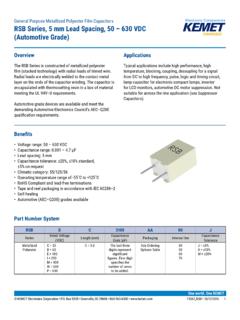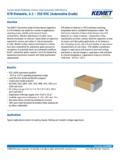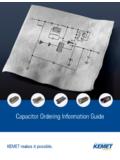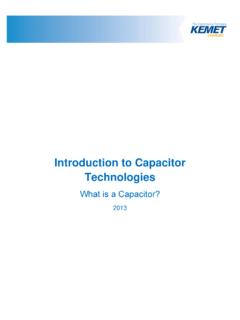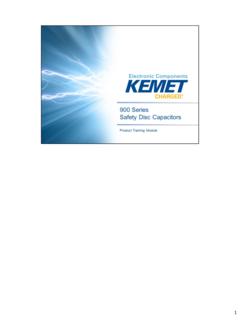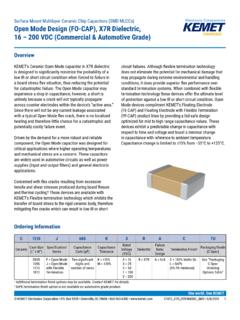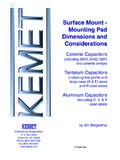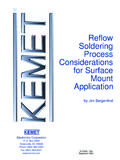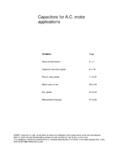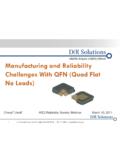Transcription of Technical Update - Ceramic versus Tantalum 2008 …
1 2004 kemet Electronics Corp. E-mail: Page 1 of 6 Technical Update Comparison of Ceramic and Tantalum Capacitorsi BASIC DIFFERENCES Ceramic capacitors have a multitude of dielectric types available and each of these types is characterized by their sensitivities to temperature, but not to voltage or time. This paper compares the X7R, X6S, or X5R dielectric types of ce-ramic capacitors with Tantalum capacitors . Ceramic capaci-tors constructed with these dielectrics offer moderate dielec-tric constants with moderate temperature and voltage sensi-tivities. They overlap with Tantalum capacitors in capaci-tance/voltage range offerings. In many cases, the solder pad geometry allows swapping of Ceramic 0603, 0805, 1206 or 1210 chip sizes with J, R, A, or B case tantalums, re-spectively.
2 Among the more rudimentary differences between ce-ramic and Tantalum capacitor types are factors of polarity, temperature, DC bias effect, AC signal level effects, and fre-quency response with the parasitic contributions within There are significant differences in construction between multilayer Ceramic (MLC) and Tantalum capacitors . The ce-ramic MLC chip is a Ceramic block with end metallizations applied to the opposing end termination faces (T1 & T2). This creates wrap-around metal pads on the adjacent faces, and these pads are soldered directly to the printed wire board (PWB) along the bottom of the chip. The active element of the Tantalum capacitor is a metal-dominated structure that is encased in plastic, with leadframes extending out from the plastic to allow a leadframe wrap-under (T1 & T2), which creates metal pads along the bottom of the package to facili-tate the soldering to the PWB.
3 Plastic encapsulation and pro-truding metal leadframes act to protect the active Tantalum capacitor elements during mounting to the PWB, and from environmental exposure during operation. However, the plas-tic encapsulation limits the maximum temperature of solder-ing due to thermal degradation and mismatch of coefficient of thermal expansion (CTE) between the plastic and the active capacitor element. The additional leadframe required with this package leads to higher inductive parasitics for Tantalum capacitors as compared to Ceramic capacitors . From the perspective of mechanical properties, the pack-aging differences that electrically favored the Ceramic now favor the Tantalum after the chip is soldered to the PWB. Be-cause the Ceramic is rigidly fixed to the PWB with the solder attachment, any mechanical stresses created in the PWB (flex, stretch, shock, and vibration) are now transferred di-rectly to the Ceramic body.
4 These Ceramic materials have enormous compressive capability, but have little tensile capa-bility. The shear forces generated can lead to cracking of the Ceramic structure, which leads to capacitor failures (short cir-cuits). The leadframe of the Tantalum chip allows mechanical isolation of the Tantalum structure within the plastic encapsu-late from the PWB. Table 1. Shared elements between these two types. NEARLY-SHARED ELEMENTS In comparing these types of capacitors , it would be in-structive to compare common elements as well as the distinc-tive elements of each. Table 1 contains a list of shared ele-ments for these capacitors , which have nearly common per-formance characteristics. Shared performance characteristics include similar temperature coefficients, fail-short, power re-strictions, voltage restrictions, parasitics of equivalent series resistance (ESR) and equivalent series inductance (ESL), Figure 1.
5 Tantalum and Ceramic chip O. Box 5928 Greenville, SC 29606 (864) 963-6300 (Revised) November 2008 Update 2008 kemet Electronics Corp. E-mail: Page 2 of 6 power derating, and concerns with lead-free solder applica-tions. 1. Temperature Coefficient of Capacitance (TCC) The allowable change in capacitance for two of the ce-ramic dielectrics and for Tantalum within their temperature ranges are all within a 15% window. The X7R and X5R maintain this capability from -55 C through 125 C and 85 C, respectively. The X6S dielectric Ceramic maintains capaci-tance within a 22% window from -55 C through 105 C. These changes are all with respect to the near room ambient or 25 C reference. Figure 2. Capacitance change versus temperature.
6 Figure 2 shows the typical capacitance versus tempera-ture responses of the three subject dielectrics and the tanta-lum s capacitance with temperature. The changes are all very similar in the low temperatures, but Tantalum shows the only positive characteristics in the upper temperatures. For filter-ing applications, they are very similar, as deviations within 20% will have little impact on circuit. For power supplies that are always in the temperature range above 25 C, the higher capacitance from the Tantalum could result in lowered impedance and improved performance. Viewing these same considerations for decoupling of hot microprocessors or de-coupling applications, the higher capacitance at elevated tem-peratures makes the Tantalum response more desirable.
7 For both of these types of capacitors , the ESR typically has a negative temperature coefficient of resistance (TCR) as temperature increases, the ESR decreases. Though this is a common feature, the new Tantalum -polymer devices have a reduced effect negative TCR, with the high temperature ESR being very close to that of the 25 C ESR. 2. Fail-short As with most capacitor types, the main failure mode of these capacitors is a dielectric failure resulting in a potential short-circuit. There may be prejudice to the effect that the Tantalum failures are more critical, but most of this bias is created by historical difference in applications. It is only with recent developments in expanded capacitance capability for surface-mount Ceramic chips that exposure to high-power fil-ter circuitry has been enabled for the MLCC device.
8 Tanta-lum capacitors have a propensity to ignition failures (MnO2 cathode system), but this will be covered in a later section. Once the device is in a high-power, low-impedance cir-cuit, concerns for excessive DC currents that can create a thermal hot spot must be addressed with some regulation cir-cuitry or fuse. The difficulty of using many devices in paral-lel (normally required for high power) is that the normal cir-cuit operational current exceeds the burn activation of any single element. A single fuse rated above the operational cur-rent will never detect the failure. Adding fuses in series with each element is too costly and degrades the performance of a capacitor by adding ESR and ESL. There are Tantalum sur-face-mount devices that contain an internal fuse to enable the protection with minimal increase in ESR and negligible in-crease in ESL.
9 There have been no commercially acceptable fused Ceramic capacitors , to date. 3. Parasitic ESR and ESL Both of these capacitors contain parasitic ESR and ESL. The initial package geometries, being very similar in size and utilizing the same solder pad geometries, have very similar ESL values between 2 and 1 nH. In the case of the MLC (multilayer Ceramic ) however, there are opportunities for changing the aspect ratio of length and width to create much lower ESL values. This is highlighted by the 0612 chip hav-ing less than half the ESL of a 1206 chip (600 pH). This is demonstrated further with the multiterminal, interdigitated ce-ramic chip offerings that move the ESL well below 100 pH. The Tantalum ESL has recently been reduced using face-down terminations, minimizing the loop area and bringing down the ESL to less than 200 pH.
10 The ESR of MLC capacitors is typically lower than that of similar value Tantalum . The ratio of this parasitic is typi-cally 1:100. Using conductive polymers in place of the tradi-tional MnO2 cathode system has allowed this ratio to be di-minished to less then 1:10 and, in some cases, approaching unity. More information will be revealed on these parasitics later on. 4. Power derating Arbitrarily assigned power ratings for Tantalum and MLC are based on an acceptable temperature rise. Typically, this rise is given as 20 C rise over ambient. Using the thermal re-sistivity of the device, the power rating in watts is then estab-lished. As the ambient temperature approaches the maximum temperature rating of the device, the allowable rise must be reduced, approaching zero at the extreme.

